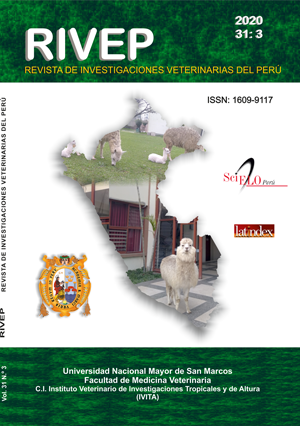Seroconversion dynamics of bovine viral diarrhea and neosporosis in dairy herds of the central highlands of Peru
DOI:
https://doi.org/10.15381/rivep.v31i3.18727Keywords:
seroprevalence, risk factors, epidemiology, ELISA, seroconversion, cattle, abortionAbstract
The aims of this study were to determine the dynamics of seroconversion of bovine viral diarrhea (DVB) and neosporosis, as well as the presence of animals persistently infected (PI) with the DVB virus in cattle farms of two experimental stations of the Universidad Nacional del Centro del Peru: In total, 111 Brown Swiss cattle in the EEA El Mantaro and 39 Holstein cattle in the GA Yauris, both located in the central highlands, Junín Region, Peru were used. Three evaluations (August 2015, and February and August 2017) were performed to detect serum antibodies against vBVD and N. caninum, and DVB antigens, using ELISA tests. The average prevalence of DVB in the EEA El Mantaro was 73.5%, the seroconversion dynamics in the herd was increasing over time, and the prevalence of PI animals was 5.4%. For GA Yauris, the average prevalence of DVB was 16.67%, the seroconversion dynamics were stable over time, and the prevalence of PI animals was 2.78%. The prevalence of neosporosis in the EEA El Mantaro was 11.8%, with an increasing but moderate seroconversion dynamic, while in GA Yauris it was 36.81% with an increasing seroconversion dynamic in the last evaluation.
Downloads
Downloads
Published
Issue
Section
License
Copyright (c) 2020 Fernando Arauco Villar, Noemí Mayorga Sánchez, Danny Cruz Flores, Jean Astohuamán Vilcahuamán

This work is licensed under a Creative Commons Attribution-NonCommercial-ShareAlike 4.0 International License.
AUTHORS RETAIN THEIR RIGHTS:
a. Authors retain their trade mark rights and patent, and also on any process or procedure described in the article.
b. Authors retain their right to share, copy, distribute, perform and publicly communicate their article (eg, to place their article in an institutional repository or publish it in a book), with an acknowledgment of its initial publication in the Revista de Investigaciones Veterinarias del Perú (RIVEP).
c. Authors retain theirs right to make a subsequent publication of their work, to use the article or any part thereof (eg a compilation of his papers, lecture notes, thesis, or a book), always indicating the source of publication (the originator of the work, journal, volume, number and date).



